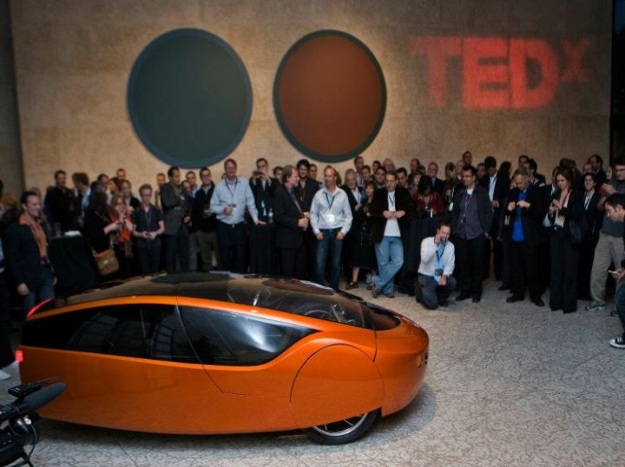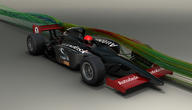
Today, most people are aware that driving automobiles is contributing too much pollution and carbon dioxide into our atmosphere. The question remains, what can we do about it? The integrated design approach used on the Urbee hybrid electric vehicle helps to greatly minimize its energy use and emissions.
Autodesk Software Used:
Figure 1: A Model of Urbee
Project Summary
While public transportation is a good solution, in many parts of the United States and the rest of the world cars remain the only viable near-future solution to transportation. Therefore, many people look to buy new, more efficient cars to reduce their impact on the environment. However, these cars are still designed with the same basic thinking as all others on the market, and unfortunately don’t add up to a long-term solution. This is where the whole systems, energy focused design thinking comes in.
The Urbee team was able to use this approach to produce a fuel efficient vehicle that achieves around 150 miles per gallon, weighs only 1,200 pounds, and has an impressively low 0.15 drag coefficient.
Design Process
The idea behind Urbee is actually quite simple: design a car that is as energy efficient as possible for meeting basic everyday needs of personal transportation.
Whole Systems Approach
The Urbee team approached this problem with a method underutilized in design: whole systems thinking. This design thinking follows the Rocky Mountain Institute’s 10xE Principles.
In whole systems thinking the aim is not to design a better product as compared to what already exists, but to look at the problem being solved and design a better solution to that (RMI 10xE Principle 10. Start with a clean sheet). This is the difference between designing a better oil lamp and thinking about the problem of on-demand personal lighting and creating the light bulb.
With this approach the Urbee team’s goal was to build a cheap, safe, and quick method of personal transportation that could rely on only the amount of energy that could be collected from an average sized housing plot (RMI 10xE Principle 1. Define shared and aggressive goals). They took this to mean a garage with solar panels and a wind turbine to supply electrical power, as well as a small plot of crops that could be turned into ethanol. While they acknowledge that few if any people will grow their own ethanol creating plants, it was a design constraint that was instrumental in reigning in their design possibilities.
Figure 2: A potential design for a garage that can power Urbee, considering energy as part of the whole systems analysis
Meet core transportation needs and start the design with a clean sheet
The first thing the team did was define the performance requirements that would meet the core needs of the user, not all theoretical wants (RMI 10xE Principle 6: Seek systemic causes and ultimate purposes).
Current design constraints include things such as passing at highway speed in a fully loaded car, various acceleration standards, and other considerations that many users will never or only rarely realize. In short, they wanted to design for averages, not peaks. So, the designers focused on the core service of everyday personal transportation (RMI 10xE Principle 5. Define the end-use; Principle 16. Meet minimized peak demand; optimize over integrated demand), and were able to create a much more efficient car by changing the underlying parameters and assumptions about how a car should look and perform.
Figure 3: A Lexus rx450h Hybrid: an example of the same thinking with new technology
Design Inspiration from Personal Rapid Transit
The idea for the Urbee was born after KOR Product Design finished designing a Personal Rapid Transit (PRT) system called the Solos Micro Metro. This PRT system was designed to travel at a steady 15 miles per hour while using only 0.1 horsepower, the equivalent amount of energy required for walking. After this project wrapped up in 1996 the question was asked to Jim - why not apply similar ideas of low energy usage into an everyday vehicle? From this, the concept for the Urbee (URBan low-energy vehicle that used both Electricity and Ethanol as fuel) was born.
Clear and Aggressive Goals, Focused on Sustainability
In order to develop a low-energy vehicle, the team first needed a plan with goals, which eventually developed into their vision/mission statement.
- Use the least amount of energy possible for every kilometer traveled.
- Cause as little pollution as possible during manufacturing, operation and recycling of the car.
- Use materials available as close as possible to where the car is built.
- Use materials that can be recycled again and again.
- Use parts and materials that last as long as possible.
- Be simple to understand, build, and repair.
- Be as safe as possible to drive.
- Meet the standards and regulations applicable to traditional cars.
- Be buildable in small quantities so we don't have to wait for it to become more widely accepted before we can begin manufacturing it for the public.
- Be mass-producible so it can be built more economically once it becomes more widely accepted.
- Be affordable.
- Be visually appealing.
Design Considerations and Requirements
The first item on the team’s list of goals – that Urbee use the least amount of energy possible for travel – was affected mainly by two variables: weight and aerodynamic efficiency. This is due to some basic physics constraints. At low speeds and stop-and-start driving, the majority of energy used is dedicated to overcoming the weight of the vehicle. At highway speeds the aerodynamic efficiency of the vehicle becomes the most important aspect when optimizing for efficiency.
Minimizing Weight
To minimize weight the Urbee team tried to reduce the car to its minimum possible size, while still able to carry two people and a small load of groceries. The size of the final car is not much larger back-to-front than a motorcycle, and utilizes a very compact shape to minimize unnecessary material and the associated mass. This reduced weight allowed for a greatly reduced powertrain as well (RMI 10xE Principle 12. Start downstream).
Figure 4: A scale representation of the Urbee frame next to a motorcycle, showing the small amount of materials involved
The powertrain is an electric ethanol hybrid, 3 wheeled, rear steered system. The electrics system is comprised of 2 electric motors at the front wheels powered by a bank of lead-acid batteries also in the front. Lead acid batteries were chosen due to their track record as a consistent performing battery. The electric system is supplemented by a 7 HP ethanol engine that can be used for longer journeys or if the batteries run low. The electric system was designed for 30 miles of travel per day, which is sufficient for the everyday needs of many people. However, the Urbee also has an internal combustion engine because people will inevitably need to take longer trips at times.
Figure 5: The Urbee powertrain
These design choices enabled a final curb weight of 1200 pounds (544kg). The Urbee team estimates that the lightest the Urbee can get is about 800 pounds. This compares very favorably to a 2012 Prius, which had a manufacturer published curb weight of just over 3000 pounds. The closer that the Urbee team can get to their lower goal, the more effectively energy will be used. However, reduced mass is often associated with decreased crash safety, and this is a problem that the Urbee team, and other ultra-lightweight vehicles teams, must carefully balance in the future.
Minimize Drag
At highway speeds, over half of the energy necessary to propel a car is lost to aerodynamic drag. The equation for the force of drag is very simple, and it allows us to understand how to improve efficiency.
Fd = 1/2 ρ v2 Cd A
This equations says that the force of drag (Fd) is equal to one half the product of the density of the fluid (ρ), the velocity of the object through the fluid (v2), the coefficient of drag (Cd), and the cross-sectional area of the object (A). (See Fluid Dynamics video for more)
From this equation it is simple to deduce that the best way to reduce the force of drag is to reduce speed, as the force grows with the square of speed. This is true, but to compete with other transportation options, the Urbee could not be too slow (the maximum speed is 60-70 mph). Additionally, they cannot control the density of the fluid, which in this case is air. This leaves only the coefficient of drag and cross-sectional area to improve on.

Figure 6: CFD modeling for aerodynamics
The coefficient of drag is a dimensionless number that is related to the shape of an object. All objects create drag, but the lowest possible drag is created by a perfectly streamlined body (like a raindrop). The value for this ideal body is 0.04. Compare this with a standard car, which often fall between 0.25 and 0.40.

Figure 7: Coefficients of drag for various objects
The coefficient of drag is unfortunately very complicated to find. It cannot be calculated by hand, and is traditionally found by using wind-tunnels, which is expensive and time consuming. Fortunately, with new technology known as computational fluid dynamics (CFD) engineers can find this value on a desktop computer.
With some designs on the computer and repeated iteration the team was able to get the coefficient of drag for Urbee down to a fantastic 0.15, which is less than half of many “efficient” cars on the road today. A key strategy they used to get there were enclosed wheel wells and a single rear wheel for steering. The rear wheel has a rotating plate that keeps the underside of the vehicle streamlined.
However, just minimizing the coefficient of drag is no good if the vehicle has a very large frontal area. To reduce this number the designers used a low sweeping roof, a low to the ground body, and a narrow width. Reducing the frontal area creates a much more efficient car at highway speeds, enabling the designers to use the significantly reduced powertrain to achieve the same cruising speed.
It is also important to note that while the aerodynamics of a car dominates at high speeds they are also a large contributor to efficiency at lower speeds. At driving speeds above 20 mph but below highway speeds (sometimes known as the urban driving cycle) aerodynamic drag can account for approximately 25 percent of fuel consumption. As many cars spend a good deal of time in this speed range, well designed aerodynamics are important for all use cases.
Moving Forward
While the Urbee team still has a long way to go to creating a commercially available automobile, technological improvements in recent years have greatly improved the viability of this type of vehicle. First, lithium-ion batteries have become much cheaper and more available. This could allow for a much lighter car with better range. Also, more efficient electric motors have become available, which could increase the electric range further. Finally, the team is looking into an even more efficient internal combustion engine, which would help reduce emissions when driving with fuel is necessary.
Figure 8: The first complete Urbee prototype at the TEDx Winnipeg conference
Software Exercise
- Download Simulation CFD for FREE from the Autodesk Student website.
- Open Simulation CFD and click on the button labeled tutorials.
- Select “External Aerodynamics: Car” under “Example Models”
- Follow the steps to understand the basics of how wind tunnel analysis can be run in Simulation CFD














